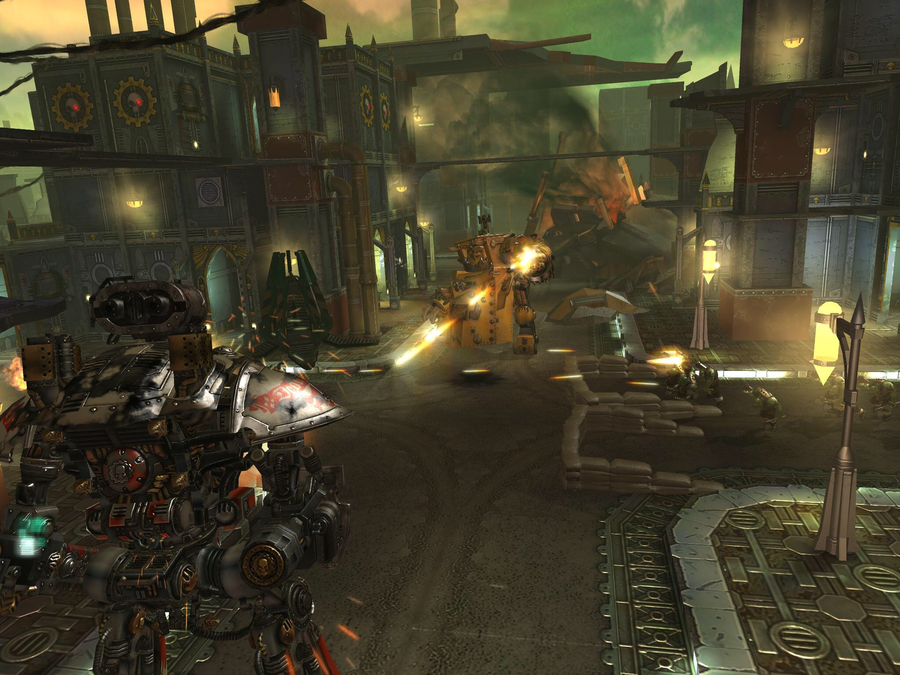Hands-on with Pixel Toy's Warhammer 40,000: Freeblade
Saw subject


I've always though that Warhammer 40,000 was is about spending hours painting tiny and intricate models, before spending a few more hours setting them up on a battlefield, before spending even more hours scrutinising your now-transformed kitchen table. And periodically getting out a tape measure.
However, after an early look at Warhammer 40k: Freeblade in the office of its developer Pixel Toys, it seems I was mistaken.
It seems that 40k is really about badass future-knights chucking their weight around, neo-medieval architecture being blown to bits, and an explosive, slightly classist crusade against some pugnacious, cockney-inspired orks.
Two things should be clear from these opening paragraphs: that Freeblade is a rather action-focused affair, and that I don't know much about Warhammer 40k.
Broadening the niche
But that's okay. Rigorous knowledge of the universe and lore is not a prerequisite to enjoyment here, and it's very much designed as such.
Freeblade is, after all, a mobile on-rails shooter - a genre in which your very fingers are transformed into heavy-duty weapons - so there's a basic inclusiveness here whether you're one of the 40k faithful or an uneducated noob.
However, that doesn't mean that the use of the licence is flimsy.
Far from it, in fact. The Pixel Toys office was strewn with Warhammer 40k models, books, and other miscellaneous trinkets when I went to visit, showing the extent to which the team has immersed itself in the world of Warhammer.
It focuses on an intriguing and relatively untapped part of 40k lore, too, putting you in the bulky, mech-like armour of a Freeblade.
Freeblades are former Imperial Knights, the hulking nobility of the Warhammer world, who have shed their allegiance to a house in order to pursue their cause alone - that cause, for the most part, being to shoot thousands of orks.
Aim and fire
Getting the shooting right is fairly crucial, then. The fact that Pixel Toy's last game, a zombie shooter called Gunfinger, had a control scheme we described as "how it should be," bodes well.
With the dev keen to avoid virtual sticks, you'll be touching and dragging to mow down ork hordes, touching with two fingers to launch rockets against tanks and bigger enemies, and double-tapping to release a torrent of missiles against multiple enemies.
You'll also be hitting circled areas to block certain incoming attacks, and quite quickly it becomes a frantic plate-spinning exercise as your path ahead clutters with different enemy types.
Orks drive in on cobbled-together yet well-equipped vehicles, backed up by more fearsome-looking enemies with armour almost as ludicrously broad-shouldered as your own. But all will buckle under your fire, and - crucially - kills feel weighty and satisfying.
Squaring up
Sometimes, in encounters with the bigger enemies, you can choose to initiate a melee encounter. The camera angle will shift, and you'll find yourself employing well-timed taps to strike with your chainsword.
It's essentially a QTE system, in which there are three outcomes for any attack scenario depending on your timing.
There's a critical hit (ordinarily enough to dispatch an enemy), a hit (mostly does non-fatal damage), and a miss (has you flounder like a buffoon unworthy of his big metal overalls and get a slap for your troubles).
But it's all over in seconds, and given how good the shooting feels the melee stands out as a weak spot.
Missions are each about two to three minutes in length: a concession to mobile play patterns, so perhaps the short bouts are understandable. But this should be a chance to get up close and really go to town with that chainsword, and at the moment it doesn't really live up to the promise.
The fighting animations themselves - with over two hundred combinations depending on enemy type, hit strength, and camera angle - are very impressive, maintaining the incredibly high graphical standard maintained throughout.
It'd just be nice to be a bit more involved - although that's a minor quibble.
Devil in the details
There's a tiny, tiny detail about Warhammer 40k: Freeblade that really impressed me: when you're customising your armour, the colours on offer are all the exact shades you can buy in little paint pots from Games Workshop.
The idea being that you can tinker with the design of your playable character, just as you would if he were a model you'd purchased.
Furthermore, the game's story is penned by an author who's written 40k fiction for the Games Workshop-affiliated Black Library, and the soundtrack comes from a musician who's contributed to Warhammer audiobooks.
I think this speaks volumes for the game as a whole. There's clear respect for its source material, and that's lovely to see whether you're a 40k fanboy or not.
It's worth noting that Warhammer 40k: Freeblade is a free-to-play game, although not much of its systems were on show at preview stage. So, as ever, that could be a factor in how the game is perceived upon launch.
However, judging purely by gameplay, Freeblade's looking pretty solid. Just make the most of that chainsword, eh?
